Enhanced Adsorption of Gaseous Naphthalene by Activated Carbon Fibers at Elevated Temperatures
Abstract
1. Introduction
2. Experimental Section
2.1. Preparation of ACFs
2.2. Characterization of ACFs
2.3. Dynamic Adsorption of Naphthalene and Toluene
2.4. Adsorption Equilibrium Model
3. Results and Discussion
3.1. Characterization of the ACFs
3.2. Effects of ACF Characteristics on Naphthalene Adsorption
3.3. Adsorption Equilibrium of Naphthalene
3.4. Competitive Adsorption of Gaseous Naphthalene and Toluene
3.5. The Changes in Functional Groups on ACFs before and after Adsorption of Naphthalene
4. Conclusions
Author Contributions
Funding
Institutional Review Board Statement
Informed Consent Statement
Data Availability Statement
Conflicts of Interest
References
- Zhu, L.; Shen, D.; Luo, K.H. A critical review on VOCs adsorption by different porous materials: Species, mechanisms and modification methods. J. Hazard. Mater. 2020, 389, 122102. [Google Scholar] [CrossRef] [PubMed]
- Zhang, X.Y.; Gao, B.; Creamer, A.E.; Cao, C.C.; Li, Y.C. Adsorption of VOCs onto engineered carbon materials: A review. J. Hazard. Mater. 2017, 338, 102–123. [Google Scholar] [CrossRef] [PubMed]
- Liu, Z.S.; Li, W.K.; Hung, M.J. Simultaneous removal of sulfur dioxide and polycyclic aromatic hydrocarbons from incineration flue gas using activated carbon fibers. J. Air Waste Manag. 2014, 64, 1038–1044. [Google Scholar] [CrossRef] [PubMed]
- Romero-Anaya, A.J.; Lillo-Ródenas, M.A.; Linares-Solano, A. Activation of a spherical carbon for toluene adsorption at low concentration. Carbon 2014, 77, 616–626. [Google Scholar] [CrossRef]
- Li, X.; Zhang, L.; Yang, Z.; Wang, P.; Yan, Y.; Ran, J. Adsorption materials for volatile organic compounds (VOCs) and the key factors for VOCs adsorption process: A review. Sep. Purif. Technol. 2020, 235, 116213. [Google Scholar] [CrossRef]
- Yang, C.T.; Miao, G.; Pi, Y.H.; Xia, Q.B.; Wu, J.L.; Li, Z.; Xiao, J. Abatement of various types of VOCs by adsorption/catalytic oxidation: A review. Chem. Eng. J. 2019, 370, 1128–1153. [Google Scholar] [CrossRef]
- Lin, C.L.; Cheng, Y.H.; Liu, Z.S.; Chen, J.Y. Adsorption and oxidation of high concentration toluene with activated carbon fibers. J. Porous Mater. 2013, 20, 883–889. [Google Scholar] [CrossRef]
- Meng, F.Y.; Song, M.; Wei, Y.X.; Wang, Y.L. The contribution of oxygen-containing functional groups to the gas-phase adsorption of volatile organic compounds with different polarities onto lignin-derived activated carbon fibers. Environ. Sci. Pollut. Res. 2019, 26, 7195–7204. [Google Scholar] [CrossRef]
- Yue, Z.R.; Vakili, A.; Wang, J.W. Activated carbon fibers from meltblown isotropic pitch fiber webs for vapor phase adsorption of volatile organic compounds. Chem. Eng. J. 2017, 330, 183–190. [Google Scholar] [CrossRef]
- Hong, T.; Wei, L.; Cui, K.; Dong, Y.; Li, R.; Zhang, T.; Zhao, Y.; Luo, L. Adsorption performance of volatile organic compounds on activated carbon fibers in a fixed bed column. J. Environ. Chem. Eng. 2021, 9, 106347. [Google Scholar] [CrossRef]
- Khodwe, M.S.; Ashlesha, M. Adsorption kinetic studies of activated carbon fabric for the removal of volatile organic components. Mater. Today Proceed. 2022, 68, 1051–1056. [Google Scholar] [CrossRef]
- Yan, M.; Rong, Y.; Wu, F.; You, Z.X.; Wang, D.S.; Yang, X.D.; Hao, Z.P.; Li, J.J.; Zhang, Z.S. Micro-mesoporous graphitized carbon fiber as hydrophobic adsorbent that removes volatile organic compounds from air. Chem. Eng. J. 2023, 452, 139184. [Google Scholar] [CrossRef]
- Hou, S.Y.; Tang, Y.L.; Zhu, T.L.; Huang, Z.H.; Liu, Y.S.; Sun, Y.; Li, X.; Shen, F.X. Adsorptive removal of gas phase naphthalene on ordered mesoporous carbon. J. Hazard. Mater. 2022, 436, 129208. [Google Scholar] [CrossRef]
- Hou, S.Y.; Tang, Y.L.; Zhu, T.L.; Huang, Z.H.; Liu, Y.S.; Sun, Y.; Li, X.; Shen, F.X. The molecular simulation and experimental investigation of toluene and naphthalene adsorption on ordered porous silica. Chem. Eng. J. 2022, 435, 134844. [Google Scholar] [CrossRef]
- Liu, Y.S.; Zhao, C.Y.; Li, Z.Y.; Meng, M.M.; Yang, X.; Bian, W.B.; Wu, H.Y.; Zhang, C.Z.; Wang, J.; Tsai, C.J.; et al. Adsorption and desorption of gaseous naphthalene on carbonaceous sorbents: Insights into advantageous pore sizes and morphologies. J. Clean. Prod. 2021, 314, 127905. [Google Scholar] [CrossRef]
- Ma, X.W.; Li, S.Y.; Hou, Y.; Lv, H.; Li, J.J.; Cheng, T.Y.; Yang, L.J.; Wu, H. Adsorption of low-concentration organic pollutants from typical coal-fired power plants by activated carbon injection. Process Saf. Environ. 2022, 159, 1174–1183. [Google Scholar] [CrossRef]
- Wang, J.Y.; Cao, W.; Wei, W.W.; Jin, H. Adsorption characteristic analysis of PAHs on activated carbon with different functional groups by molecular simulation. Environ. Sci. Pollut. Res. 2023, 30, 32452–32463. [Google Scholar] [CrossRef] [PubMed]
- Zhang, Z.B.; Jiang, C.; Li, D.W.; Lei, Y.Q.; Yao, H.M.; Zhou, G.Y.; Wang, K.; Rao, Y.L.; Liu, W.G.; Xu, C.L.; et al. Micro-mesoporous activated carbon simultaneously possessing large surface area and ultra-high pore volume for efficiently adsorbing various VOCs. Carbon 2020, 170, 567–579. [Google Scholar] [CrossRef]
- Majd, M.M.; Kordzadeh-Kermani, V.; Ghalandari, V.; Askari, A.; Sillanpää, M. Adsorption isotherm models: A comprehensive and systematic review (2010–2020). Sci. Total Environ. 2022, 812, 151334. [Google Scholar] [CrossRef]
- Zhang, X.; Chen, S.; Bi, H.T. Application of wave propagation theory to adsorption breakthrough studies of toluene on activated carbon fiber beds. Carbon 2010, 48, 2317–2326. [Google Scholar] [CrossRef]
- Ryu, Z.Y.; Zheng, J.T.; Wang, M.Z.; Zhang, B.J. Characterization of pore size distributions on carbonaceous adsorbents by DFT. Carbon 1999, 37, 1257–1264. [Google Scholar] [CrossRef]
- Brunauer, S.; Deming, L.S.; Deming, W.E.; Teller, E. On a theory of the van der Waals adsorption of gases. J. Am. Chem. Soc. 1940, 62, 1723–1732. [Google Scholar] [CrossRef]
- Chen, T.; Fu, C.; Liu, Y.; Pan, F.; Wu, F.; You, Z.; Li, J. Adsorption of volatile organic compounds by mesoporous graphitized carbon: Enhanced organophilicity, humidity resistance, and mass transfer. Sep. Purif. Technol. 2021, 264, 118464. [Google Scholar] [CrossRef]
- Demiral, İ.; Samdan, C.; Demiral, H. Enrichment of the surface functional groups of activated carbon by modification method. Surf. Interfaces 2021, 22, 100873. [Google Scholar] [CrossRef]
- Alslaibi, T.M.; Abustan, I.; Ahmad, M.A.; Foul, A.A. Cadmium removal from aqueous solution using microwaved olive stone activated carbon. J. Environ. Chem. Eng. 2013, 1, 589–599. [Google Scholar] [CrossRef]
- Socrates, G. Infrared and Raman Characteristic Group Frequencies: Tables and Charts; John Wiley & Sons: Hoboken, NJ, USA, 2004. [Google Scholar]
- Moreno-Castilla, C. Adsorption of organic molecules from aqueous solutions on carbon materials. Carbon 2004, 42, 83–94. [Google Scholar] [CrossRef]
- Radovic, L.; Silva, I.; Ume, J.; Menéndez, J.; Leon, C.L.Y.; Scaroni, A. An experimental and theoretical study of the adsorption of aromatics possessing electron-withdrawing and electron-donating functional groups by chemically modified activated carbons. Carbon 1997, 35, 1339–1348. [Google Scholar] [CrossRef]
- Radovic, L.R.; Moreno-Castilla, C.; Rivera-Utrilla, J. Carbon materials as adsorbents in aqueous solutions. In Chemistry & Physics of Carbon; CRC Press: Boca Raton, FL, USA, 2001; pp. 227–406. [Google Scholar]
- Yang, K.; Xing, B. Adsorption of organic compounds by carbon nanomaterials in aqueous phase: Polanyi theory and its application. Chem. Rev. 2010, 110, 5989–6008. [Google Scholar] [CrossRef]
- Efremenko, I.; Sheintuch, M. Predicting solute adsorption on activated carbon: Phenol. Langmuir 2006, 22, 3614–3621. [Google Scholar] [CrossRef] [PubMed]
- Pei, Z.; Li, L.; Sun, L.; Zhang, S.; Shan, X.-Q.; Yang, S.; Wen, B. Adsorption characteristics of 1,2,4-trichlorobenzene, 2,4,6-trichlorophenol, 2-naphthol and naphthalene on graphene and graphene oxide. Carbon 2013, 51, 156–163. [Google Scholar] [CrossRef]

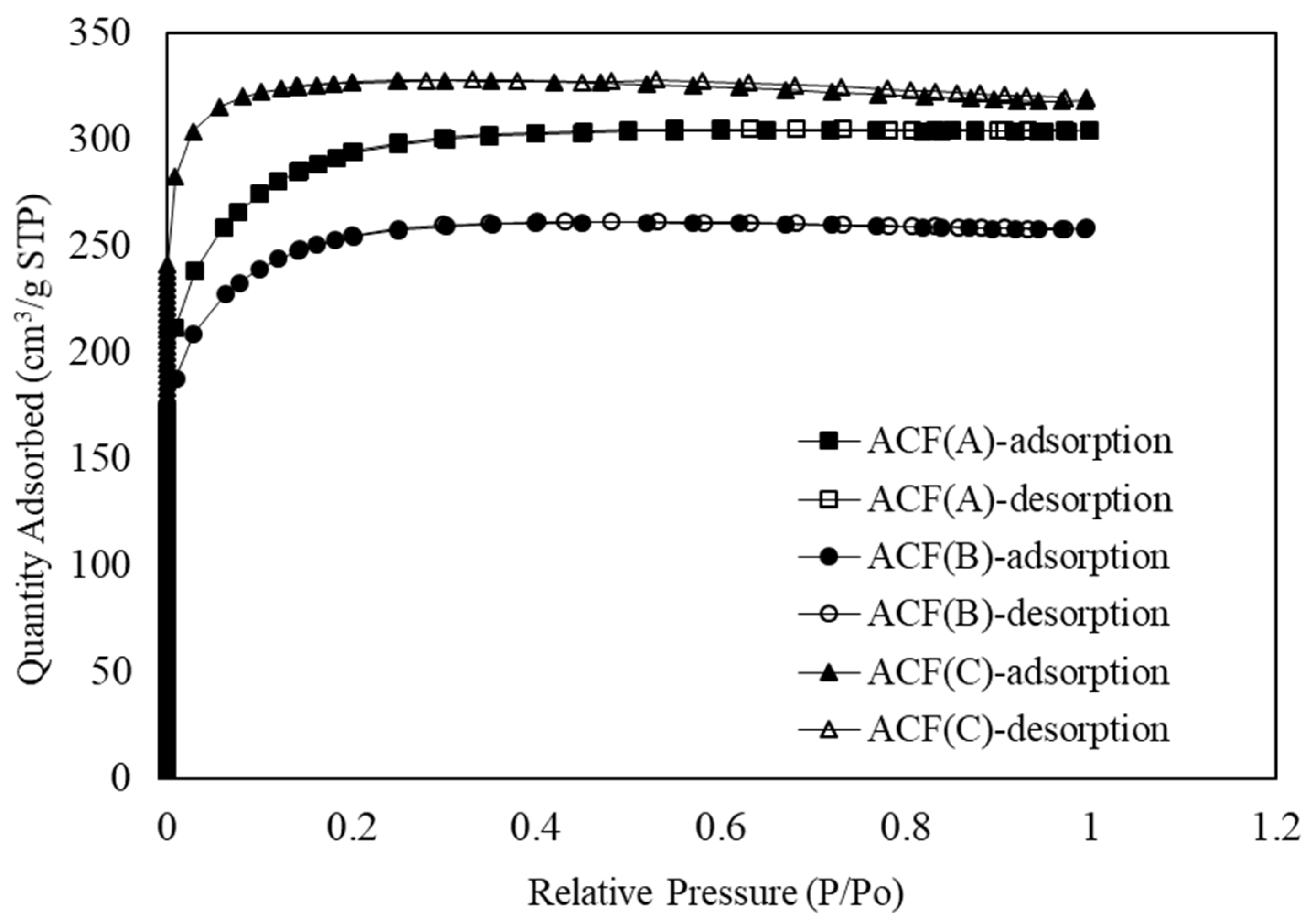
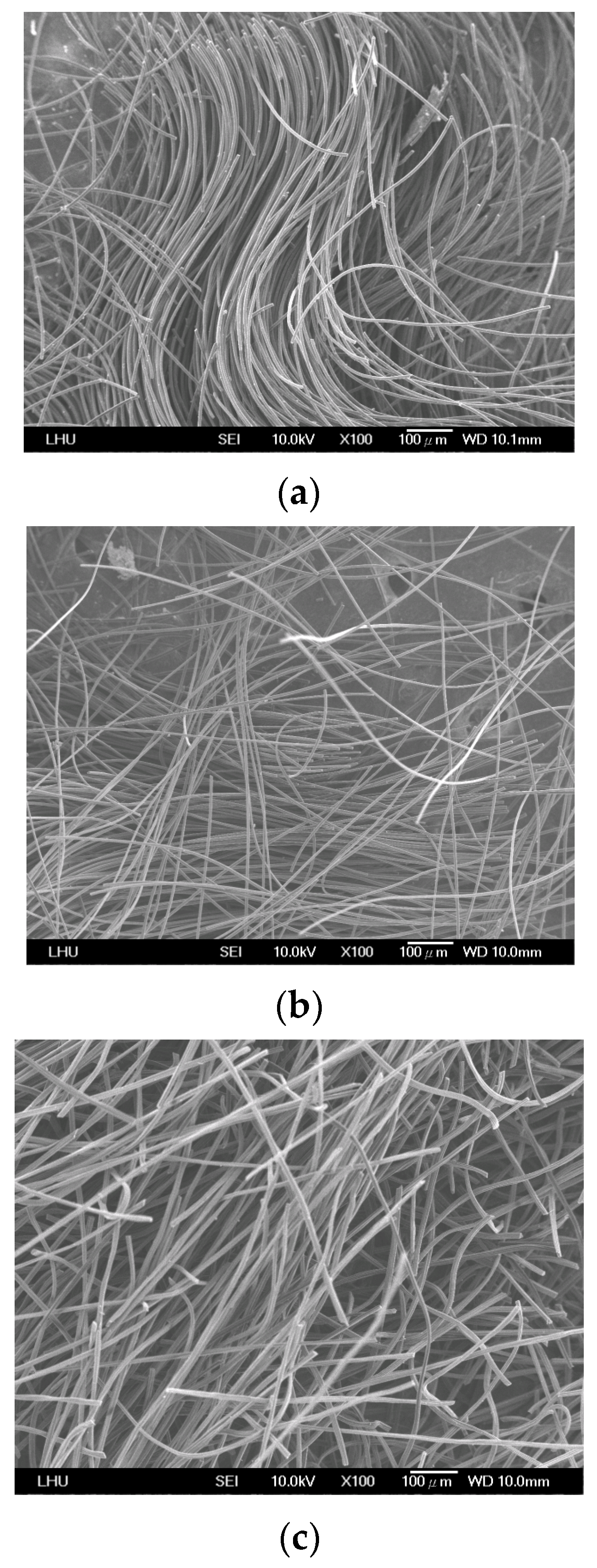
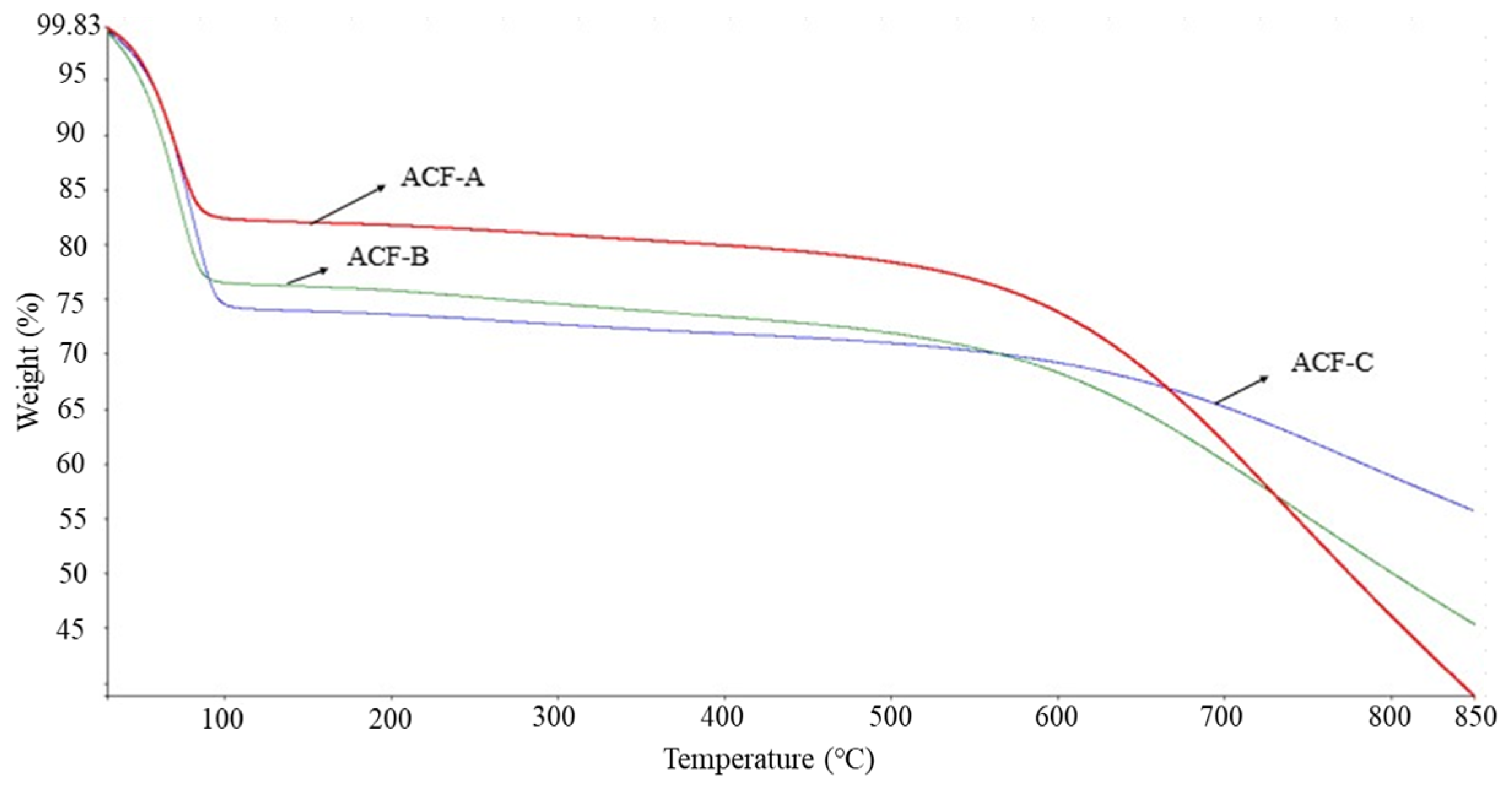

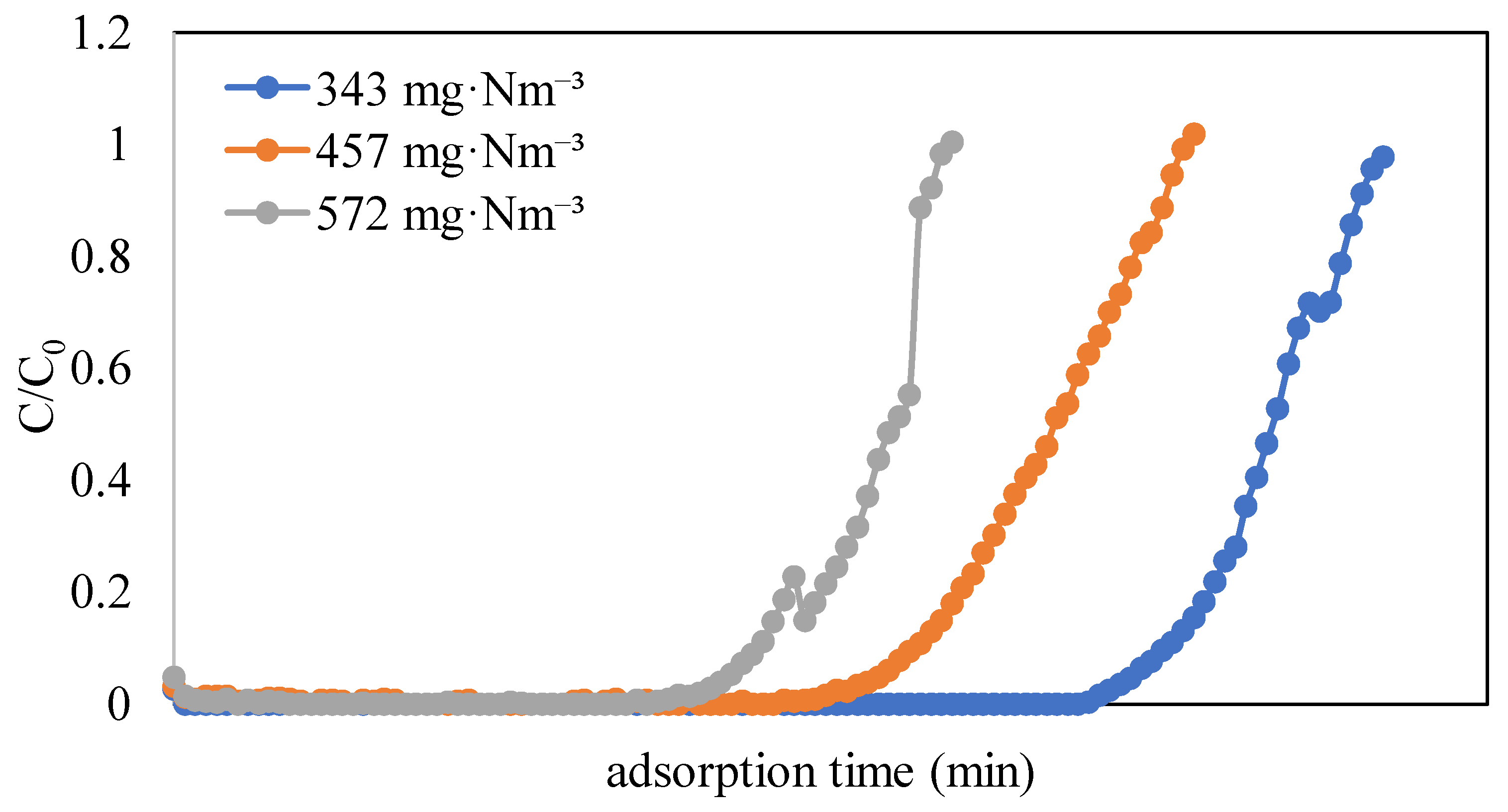
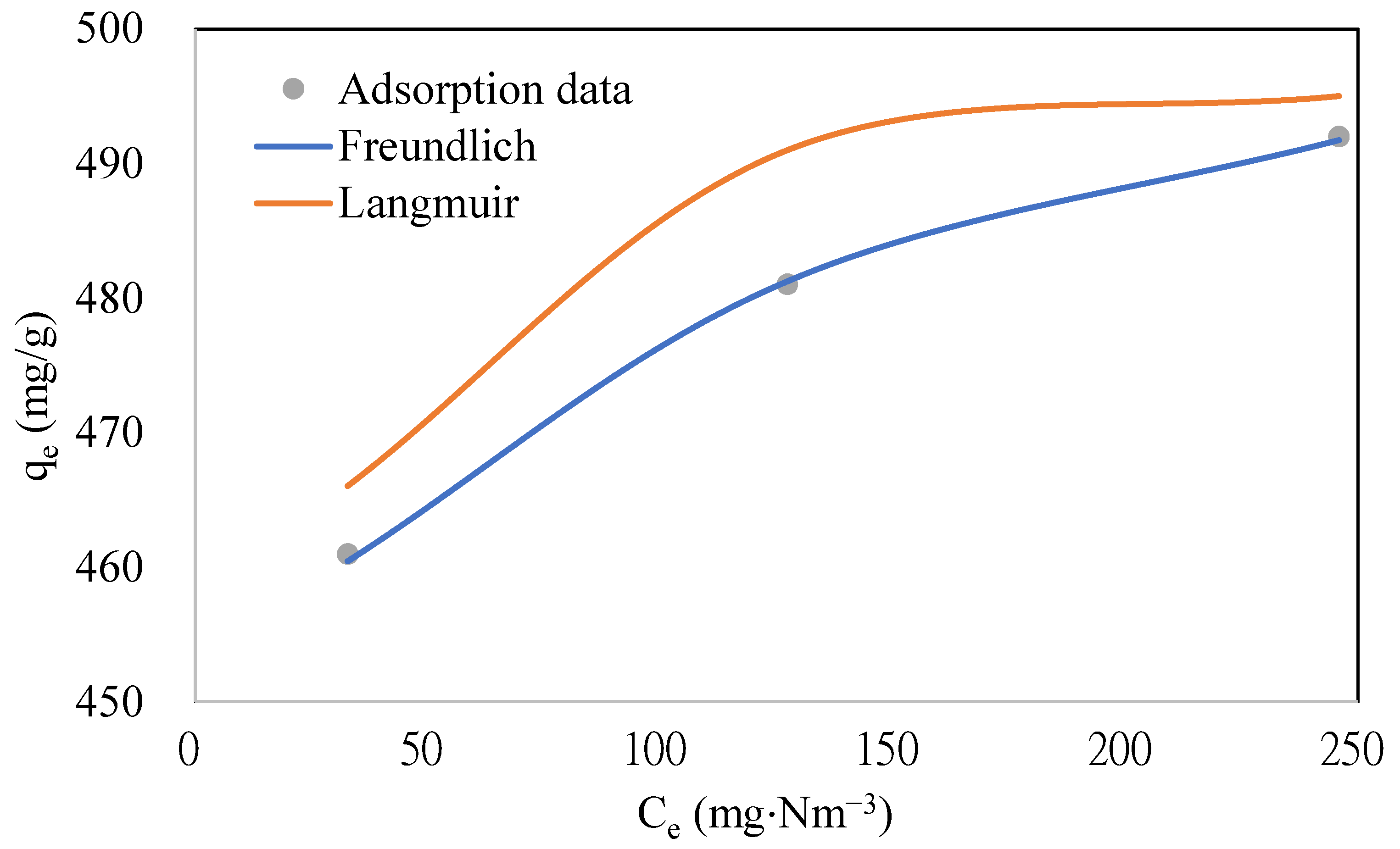
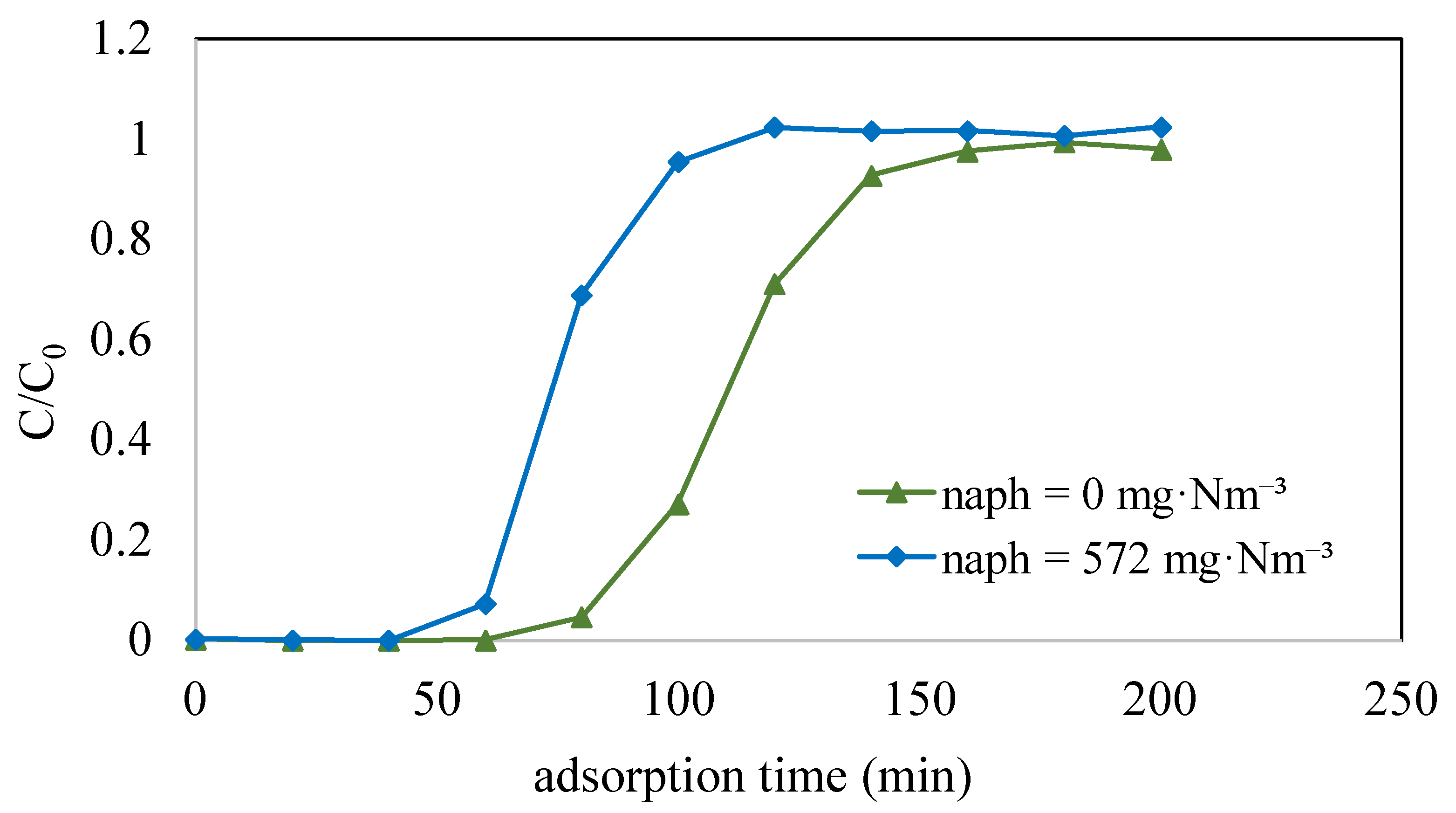


| Sample | SBET a (m2/g) | VT b (cm3/g) | Vmeso c (cm3/g) | Vmicro d (cm3/g) | dp e (nm) |
|---|---|---|---|---|---|
| ACF-A | 1013 | 0.47 | 0.2 | 0.27 | 1.86 |
| ACF-B | 874 | 0.40 | 0.15 | 0.25 | 1.83 |
| ACF-C | 1098 | 0.49 | 0.03 | 0.46 | 1.79 |
| ACFs Type | Naphthalene Concentration (mg·Nm−3) | Toluene Concentration (mg·Nm−3) | Adsorption Temperature (°C) | Saturated Adsorption Capacity (mg/g) | ||
|---|---|---|---|---|---|---|
| Naphthalene | Toluene | |||||
| Run 1 | ACF-A | 572 | 0 | 70 | 493 | – |
| Run 2 | ACF-B | 401 | – | |||
| Run 3 | ACF-C | 345 | – | |||
| Run 4 | ACF-A | 343 | 461 | – | ||
| Run 5 | 457 | 481 | – | |||
| Run 6 | 0 | 4110 | – | 293 | ||
| Run 7 | 572 | 2055 | 469 | 176 | ||
| Run 8 | 2877 | 446 | 190 | |||
| Run 9 | 4110 | 450 | 213 | |||
| Langmuir Isotherm | Freundlich Isotherm | |||||
|---|---|---|---|---|---|---|
| qm (mg·g−1) | kL (m3·mg−1) | R2 | kF (mg·g−1)(m3·mg−1)1/n | n | R2 | |
| Naphthalene (Run 1 and Runs 4–5) | 500 | 0.417 | 0.952 | 410.92 | 30.67 | 0.998 |
| Toluene (Runs 7–9) | 224 | 0.0043 | 0.910 | 64.85 | 6.76 | 0.973 |
| Adsorbate | Adsorbent | Adsorption Capacity (mg g−1) | Experimental Condition | Reference |
|---|---|---|---|---|
| (1) naphthalene (2) toluene (3) binary-component | ordered mesoporous carbon (OMC) | (1) Qnap = 1284 (2) Qtol = 227 (3) Qnap = 1210, Qtol = 8 | naph conc. = 200 mg⋅m−3, tol conc. = 400 mg⋅m−3, 25 °C, RH < 1% | [13] |
| naphthalene | (1) ordered mesoporous carbons (CMK-5) (2) carbon nanotubes (SWCNT) (3)activated carbon | (1) Qnap = 222 (2) Qnap = 113 (3) Qnap = 190 | naph conc. = 1024 mg⋅m−3, 125 °C | [15] |
| toluene | KOH-porous graphitized carbon fibers (PGCFs) | Qtol = 662 | tol conc. = 3760 mg⋅m−3, 25 °C | [12] |
| toluene | (1) porous graphitized carbon (PGC) (2) activated carbon | (1) Qtol = 426 (2) Qtol = 169 | tol conc. = 3760 mg⋅m−3, 25 °C | [23] |
Disclaimer/Publisher’s Note: The statements, opinions and data contained in all publications are solely those of the individual author(s) and contributor(s) and not of MDPI and/or the editor(s). MDPI and/or the editor(s) disclaim responsibility for any injury to people or property resulting from any ideas, methods, instructions or products referred to in the content. |
© 2024 by the authors. Licensee MDPI, Basel, Switzerland. This article is an open access article distributed under the terms and conditions of the Creative Commons Attribution (CC BY) license (https://creativecommons.org/licenses/by/4.0/).
Share and Cite
Lin, C.-L.; Huang, C.-Y.; Liu, Z.-S. Enhanced Adsorption of Gaseous Naphthalene by Activated Carbon Fibers at Elevated Temperatures. Toxics 2024, 12, 537. https://doi.org/10.3390/toxics12080537
Lin C-L, Huang C-Y, Liu Z-S. Enhanced Adsorption of Gaseous Naphthalene by Activated Carbon Fibers at Elevated Temperatures. Toxics. 2024; 12(8):537. https://doi.org/10.3390/toxics12080537
Chicago/Turabian StyleLin, Chiou-Liang, Chun-Yi Huang, and Zhen-Shu Liu. 2024. "Enhanced Adsorption of Gaseous Naphthalene by Activated Carbon Fibers at Elevated Temperatures" Toxics 12, no. 8: 537. https://doi.org/10.3390/toxics12080537
APA StyleLin, C.-L., Huang, C.-Y., & Liu, Z.-S. (2024). Enhanced Adsorption of Gaseous Naphthalene by Activated Carbon Fibers at Elevated Temperatures. Toxics, 12(8), 537. https://doi.org/10.3390/toxics12080537







